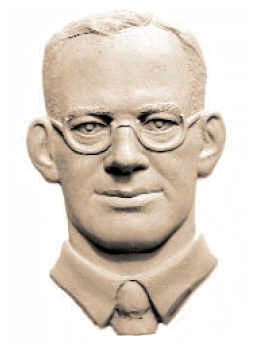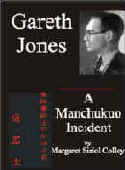Gareth Jones
[bas relief by Oleh Lesiuk]
HOME |
Stop Press |
Complete Soviet Articles & Background Information |
Précis of Gareth's
|
All Published Articles |
BOOKS
|
|
|
|
More Than Grain of Truth(2005) |
|
|
TOPICAL
'Are you Listening NYT?' U.N. Speech - Nov 2009 |
Gareth Recognised at Cambridge - Nov 2009 |
Reporter and the Genocide - Rome, March 2009 |
Order of Freedom Award -Nov 2008 |
Premiere of 'The Living' Documentary Kyiv - Nov 2008 |
Gareth Jones 'Famine' Diaries - Chicago 2008 |
Aberystwyth Memorial Plaque 2006 |
GENERAL
Scholarship Fund |
Site Map |
Links |
Legal Notices |
Sponsored Links |
Contact |
The Western Mail, April 8th, 1931
Russia's Future
- - -
STUPENDOUS PLAN OF COMMUNISTS.
- - -
COAL, IRON & STEEL.
A VAST SCHEME FOR AGRICULTURE
---
By GARETH JONES.
October
1, 1928, was a Red Letter Day in the history of the Union of Soviet Socialist
Republics. It was the day on which the Five-Year Plan was launched. The hopes of
the Communists were high. Although they only numbered 1 1/2 millions out of a
population of over 150 millions, they were determined to make Russia into an
industrialised Communist State.
Wherever
one went one saw huge banners stretched from one lamp-post to another across the
street with the words, “Let us reply to the furious arming of the capitalists
by carrying out the Five-Year Plan,” or “God and the drunkard are the
enemies of the Five-Year Plan.” The cinemas had films explaining what the
Five-Year Plan was.
At street
corners, in factories, in villages, Communists would harangue the crowds and
tell them of the three main aims of the Plan and how its fulfilment would bring
them health and happiness and save them from being attacked and murdered by the
foreigner who was waiting to pounce on Mother Russia.
WHAT THE WORKERS WERE TOLD.
This is what the
factory workers, the peasants, the teachers, and the miners learned as they
listened, open-mouthed, to the Bolshevik orators. They learned that the
Five-Year Plan had three great aims. It would first of all convert the Russia of
the peasant into the Russia of the mechanic; it would industrialise Russia and
set up factories and mines everywhere. It would, secondly, turn the millions
of strips the private property of the small peasants into big Socialist farms,
where the land would be owned in common and where the tractor and the latest
machinery would double or treble the amount of grain produced. It would,
thirdly, exterminate all capitalist elements. That meant that by 1933 every
hawker, shopkeeper, barber, tailor who worked or sold for his own profit and not
for a State shop or co-operative shop would disappear. That meant also that the
individual peasant who had his own land would be no more.
THE BIGGEST YET
With its three
aims, the industrialisation of Russia, the socialization of agriculture, and
the extermination of the private trader, the Five-Year Plan is the most thorough
revolution which has ever been attempted in the history of the world.
What it seeks to achieve in the industrial field is stupendous. The exact figures of what production must be in each year up to 1933 are worked out. Did not the whole daring of the scheme take one's breath away, one might almost be compelled to laugh at some of its stipulations. For example, it was laid down that the average number of eggs eaten per head by the people in the towns between October 1, 1932, and September 30, 1933, was to be 155. The allowance of boots was to increase from 0.40 of a pair in 1927-28 to 0.74 of a pair in 1932-33!
In other branches
of industry the progress planned is enormous.
CONCERNING
COAL.
Take coal.
In 1913 Russia produced 29 million tons of coal. By the year preceding the
Five-Year Plan this had increased to 35 million tons. By the end of the
Five-Year Plan it is planned to produce 125,000,000 tons of coal! That is almost
five times as much as in 1913! This year the figure is to leap up to 83
million tons.
The Donetz Basin
takes the first place In the Soviet coal plans. Its output is to increase from
27 million tons in 1927-28 to 70 million tons in 1933. The Donetz Basin has thus
undertaken the task of more than doubling its coal production within live years.
An immense construction programme is being carried out; seventeen new large
shafts have recently been sunk. By the end of the Plan 50 large new mines will
be in process of construction. The very face of the Donetz Basin is to be
changed. Mechanisation is to go ahead full-speed, and a great housing programme
is to be carried out.
Then comes what
is known as the sleeping giant of Russia, the Kuznetz Basin in Siberia. Its
coal reserve is estimated at the incredible figure of 300 billion tons. Eight
new large wines are to be constructed in the Kuznetz Basin. Its output will be
small at the end of the Plan, viz., Six million tons, but the Soviet authorities
intend to push ahead its development after the Five-Year Plan is over. The Ural
coat region is to increase its production from two million tons in 1927-28 to
six million tons in 1932-33.
The Moscow
district, where there are large reserves of low-grade coal, comes next. Its
output is to increase from one million to four or five million tons between the
first and the last year of the Plan. Even in the far-off Soviet lands of Central
Asia and Transcaucasia coal development plans are to be pushed ahead.
IRON AND STEEL
There is
going to be a great drive in increasing the production of iron and steel.
The iron
and steel mills in the two important metallurgical regions of the country (the
Donetz Basin and the Urals) are to be rebuilt. Many new blast furnaces are to
be constructed.
The output of oil
is to reach 42,000,000 tons by 1933. This is a tremendous rate of increase
compared with the 11,000,000 tons of 1927-28.
The production of
agricultural machinery, of copper, zinc, lead, aluminium, boilers,
textiles-indeed, of all goods, is to be doubled or trebled. This year 1931 is to
see the production of Russia increase by 45 per cent!
Wages are
to be doubled. New factories of all kinds arc to be built. Electrification is to
go ahead rapidly. A network of railways is to be constructed at breakneck
speed, opening new regions to industry and trade. Waterways and roads are to be
developed to carry the ever-growing amount of goods produced.
The Plan-as
a Plan - is, indeed, stupendous.
AGRICULTURE.
In the realm of agriculture the Plan is no less ambitious. It is attempting to revolutionise the Russian village. Large collective farms are being set up. The “Kulak” class (the peasants owning three or more cows and employing labour) is to be crushed out of existence. The policy of collectivisation aims at doing away with the millions of individually owned patches and strips and at establishing large farms run by machinery and owned in common. The peasants are allowed to keep their cottage, one cow chickens, perhaps a pig or two, but the tractors and the land are common property The Communists are aiming a converting 50 per cent. of the peasants of Russia into members of collective farm by the end of this year. If that succeeds it will be a striking revolution in the lives of the 130,000,000 of Russian peasants. Besides these “collectives,” vast State farms, covering hundreds of thousands of acres, are to be set up. These are to produce millions of tons of grain for export. The timber and the fur plans are also exceedingly high.
If the Five-Year Plan were carried out in full, then it would revolutionise the life and the trade of the whole world.
Will it be carried out? This problem is puzzling, worrying and tormenting the men and women in all countries. In following articles an attempt will be made to answer this vital question.
|
|
|
|



